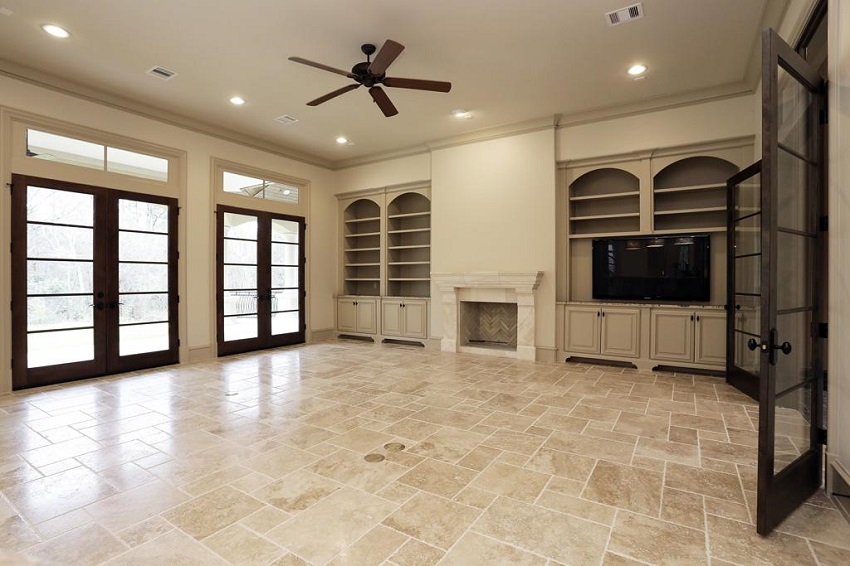
Travertine is a popular natural stone often used in construction and interior design projects. It boasts a unique blend of elegance and earthy charm, making it a desirable choice for many homeowners and designers. However, one question that frequently arises is whether travertine is an expensive stone. In this article, we will explore the cost factors, benefits, and drawbacks of travertine to determine its affordability and value for your next project. The content is brought to you by Decoracaos.com.
Understanding Travertine
Before delving into its cost, let’s first understand what travertine is. Travertine is a sedimentary rock formed by the precipitation of mineral-rich water, typically found in hot springs. It features distinct patterns and colors, ranging from warm earth tones to cooler shades, making it an aesthetically appealing option for various applications.
Types of Travertine
There are different types of travertine marble available in the market, each varying in quality and cost. The classification typically includes premium, standard, and commercial grades. Premium grade offers the highest quality and is more expensive due to its consistency and fewer imperfections. Standard grade has some natural imperfections but remains a cost-effective choice. Commercial grade, on the other hand, may be more affordable, but it tends to have more significant flaws and variations in color.
Factors Affecting the Cost
Several factors influence the cost of travertine. Some of the key factors include:
Grade and Quality
As mentioned earlier, the grade and quality of travertine significantly impact its price. Premium-grade travertine, with its uniform appearance and fewer imperfections, tends to command a higher price compared to lower-grade options.
Size and Thickness
The size and thickness of the travertine tiles or slabs also play a role in determining the overall cost. Larger and thicker pieces are generally more expensive due to the increased material required and the additional effort in handling and installation.
Finish and Texture
Travertine comes in various finishes, such as polished, honed, tumbled, and brushed. Each finish requires different processing methods, affecting the final cost. Additionally, textured surfaces tend to be more expensive than smooth ones.
Source and Availability
The source of the travertine and its availability in the market can influence its price. Travertine extracted from exotic locations might come with a higher price tag due to transportation and import costs.
Market Demand
Like any commodity, market demand can impact travertine prices. During periods of high demand, prices may rise, while they may stabilize or decrease during periods of lower demand.
The Benefits of Travertine
Despite the cost considerations, travertine offers several benefits that make it a worthwhile investment for many projects:
Aesthetics and Versatility
Travertine’s natural beauty and versatility allow it to blend seamlessly with various architectural styles, whether classic or contemporary. Its warm and inviting appearance adds a touch of sophistication to any space.
Durability
Travertine is a durable stone, capable of withstanding heavy foot traffic and daily wear and tear. When properly cared for, it can retain its beauty and structural integrity for decades.
Temperature Regulation
One of the unique features of travertine is its ability to regulate temperature. It remains cool underfoot even in hot weather, making it an excellent choice for outdoor applications like pool decks.
Increased Property Value
Investing in high-quality travertine flooring or countertops can enhance the value of your property. Its timeless appeal and durability can attract potential buyers or tenants.
Drawbacks of Travertine
While travertine offers numerous advantages, it’s essential to consider some potential drawbacks:
Porosity
Travertine is a porous stone, which means it can absorb liquids and stains if not adequately sealed. Regular maintenance and sealing are necessary to prevent damage from spills and moisture.
Sensitivity to Acids
Being a calcium-based stone, travertine is sensitive to acids like vinegar and citrus juices. These substances can etch the surface, leading to dull spots or marks.
Initial Cost
As discussed earlier, the initial cost of high-quality travertine can be higher compared to other flooring options. However, considering its durability and long-term benefits, it can be a cost-effective choice in the long run.
Conclusion
Travertine is a captivating and durable natural stone that adds charm to any living space or project. While it may have a higher initial cost compared to some alternatives, its unique characteristics and aesthetic appeal make it a valuable investment. Whether you choose travertine for your flooring, countertops, or outdoor spaces, its timeless elegance and durability will likely exceed your expectations.
FAQs
Is travertine suitable for high-traffic areas?
Yes, travertine is an excellent choice for high-traffic areas. Its durability allows it to withstand heavy foot traffic without losing its appeal.
Can I install travertine outdoors?
Yes, travertine is suitable for outdoor applications like patios, pool decks, and walkways. Its temperature regulation properties make it ideal for outdoor use.
How do I maintain travertine?
Regular cleaning with a mild, pH-balanced cleaner and periodic sealing will help maintain the beauty and durability of travertine.
Can I use travertine in wet areas like bathrooms?
Yes, travertine can be used in wet areas, but it requires proper sealing to prevent water damage.
Does the color of travertine fade over time?
Travertine’s color may fade slightly over time, but it typically develops an appealing patina that adds to its natural beauty.
